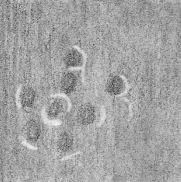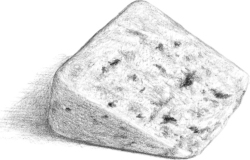TRADITIONAL STILL LIFE TEXTURES
Still life compositions allow you to have complete control: You design the composition; choose the range of textures, values, and colors; and create the ideal lighting situation. I like to set up my compositions so that there are many contrasting textures, such as a smooth piece of fruit in a coarsely woven basket. Play around with different types of fruits and cheeses to see how the light catches their textures. It’s always an added bonus to be able to share your food subject after your drawing is done!


Apple A polished red apple reflects a strong highlight, which contrasts with the skin’s dark tone. I apply carbon dust (shavings I collected from sharpening my pencils) with circular, irregular strokes (top), then lift out the highlight with an eraser (bottom).


Orange First I apply carbon dust, using strokes that follow the fruit’s form (top). I lift out the main highlight and then use an eraser to create curved strokes around the highlight, showing the bumpy texture of the orange’s skin (bottom).


Strawberry I lay in dark tone with carbon dust and use a 4B to start establishing a dotted pattern for the strawberry (top). I continue to enhance the dimpled, seeded texture by adding thin, curved highlight lines around the darker dots (bottom).


Cantaloupe With the side of a 4B, I lay down some tone and then randomly blend the graphite. I lift out a few lines to see how the lights contrast with the dark tone (top). Because the skin is very rough, there are no highlights—just the upper veining.

Weaves Baskets are incredibly tactile. The texture of the weave creates a three-dimensional pattern with many layers. Trying your hand at rendering a woven basket is a great way to learn about the interplay of light and shadow and how it can show the heavy texture of the basket.

Knotty Pine Zigzagged lines create the rough pattern of the grain. I use concentric ovals to draw the knots. Then I use an HB to add light, straight vertical strokes and individual shorter strokes to show the raised grain.

Ash For this fine-grained wood, I make long, inverted U shapes with a slightly uneven motion. Then I draw very long grain lines, varying their density and allowing the lines to curve naturally. I go over these lines with light, vertical lines.

Zebrawood With a 4B, I create the dark lines of this straight-grained hardwood. I group some closer together to indicate the color variation. I use a 2H to add very light tone with long, vertical strokes, adding a smooth quality.






